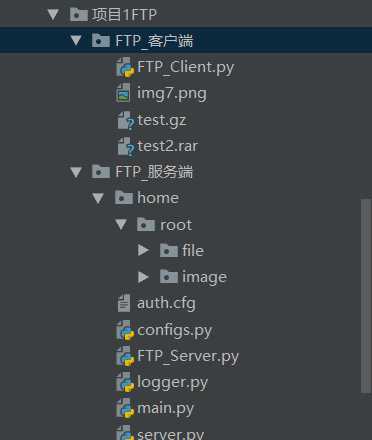标签:.section The 连接 wro 调整 ogre 数据 要求 dir


import optparse import socketserver import server import configs class ArgvHandler(): def __init__(self): #命令行解析 self.op=optparse.OptionParser() self.op.add_option(‘-S‘, ‘--server‘, dest=‘server‘) self.op.add_option(‘-P‘, ‘--port‘, dest=‘port‘) options,args=self.op.parse_args() #options的值为添加对应的值,args为输入的无关值 #进行命令分发 self.verify_args(options,args) #命令分发 def verify_args(self,options,args): print(options,args) cmd=args[0] print(cmd) if hasattr(self,str(cmd)): func=getattr(self,str(cmd)) func() #启动服务端 def start(self): #启动服务端 s=socketserver.ThreadingTCPServer((configs.IP,int(configs.PORT)),server.ServerHandler) #永久启动服务端 s.serve_forever() #帮助信息 def help(self): pass if __name__ ==‘__main__‘: ArgvHandler()

import socketserver import json import configparser import configs import os ‘‘‘ ‘‘‘ STATUS_CODE={ 250:"Invalid cmd format,e.g:{‘action‘:‘get‘,‘filename‘:‘test.py‘,‘size‘:344}", 251:"Invalid cmd", 252:"Invalid auth data", 253:"Wrong username or password", 254:"Passed authentication", 255:"Filename doesn‘t provided", 256:"File doesn‘t exist on server", 257:"ready to send file", 258:"md5 verification", 800:"the file exist,but not enough,is continue", 801:"the file exist", 802:"ready to receive datas", 900:"md5 valdate success", } #服务端处理代码 class ServerHandler(socketserver.BaseRequestHandler): def handle(self): #接收客户端信息,循环接收处理 while 1: try: data=self.request.recv(1024).strip().decode(‘utf8‘) except Exception as e: continue #将数据转成一个json字典的形式 if data : data=json.loads(data) print(data) #传过来的数据格式 # {‘action‘:‘auth‘, # ‘username‘:‘admin‘, # ‘password‘:‘123456‘} #外层判断命令是否为空 #内层循环判断是否有这个命令 if data.get(‘action‘): if hasattr(self,data.get(‘action‘)): func=getattr(self,data.get(‘action‘)) func(**data) else: print() else: print(‘‘) #认证 def auth(self,**data): username=data[‘username‘] passwd=data[‘password‘] print(username,passwd) print(4) username=self.authenticate(username,passwd) if username: self.send_reponse(254) else: self.send_reponse(253) def authenticate(self,user,passwd): print(5) cfg=configparser.ConfigParser() # cfg.read(configs.auth_path) cfg.read(‘auth.cfg‘) if user in cfg.sections(): if cfg[user][‘passwd‘]==passwd: # BASE_DIR = os.path.dirname(os.path.abspath(__file__)) self.user=user #定义用户的本地目录,在home目录下 self.mainPath=os.path.join(BASE_DIR,‘home‘,self.user) print("登陆成功") return user def send_reponse(self,state_code): print(6) response={"status_code":state_code,"status_mes":STATUS_CODE[state_code]} self.request.sendall(json.dumps(response).encode("utf-8")) #上传 def put(self,**data): print("data:",data) file_name=data.get(‘file_name‘) file_size=data.get(‘file_size‘) target_path=data.get(‘target_path‘) #这个路径对应的上传的完整路径:self.mainPath,target_path+file_name路径 #self.mainPath:home+username #self.target:文件类型 #file_name:文件名 #完整的文件名 has_receive=0 abs_path=os.path.join(self.mainPath,target_path,file_name) print(abs_path) #上传文件: # 1.已经存在这个文件:如果文件完整,则返回文件存在,如果文件不完整,则返回选择续传还是不续传 # 2.没有这个文件:直接上传文件 #对应文件打开模式:不存在:wb 续传:ab 存在完整:不打开 # 文件存在 if os.path.exists(abs_path): file_has_size=os.stat(abs_path).st_size print(file_size,file_has_size) # 文件存在,且完整 if file_size==file_has_size: print(1) self.request.sendall(‘801‘.encode("utf8")) return #断点续传 elif file_has_size<file_size: self.request.sendall(‘800‘.encode("utf8")) choice=self.request.recv(1024).decode(‘utf8‘) #续传 print(2) if choice=="Y": self.request.sendall(str(file_has_size).encode("utf8")) has_receive+=file_has_size #这里注意光标的位置,以追加方式打开,光标在文件里的位置在最后 f=open(abs_path,"ab") #不续传,重传 else: f = open(abs_path, "wb") else: #文件不存在 print(3) self.request.sendall(‘802‘.encode("utf8")) f=open(abs_path,"wb") #has_receive:已经接收到数据大小 while has_receive<file_size: try: data=self.request.recv(1024) f.write(data) has_receive+=len(data) except Exception as e: break f.close() #cd与ls都要依靠用户的self.mainPath去做处理 #而self.mainPath一直都是用户当前所在的目录 #查看文件 def ls(self,**data): file_list=os.listdir(self.mainPath) if len(file_list)==0: file_str="<empty dir>" else: file_str="\n".join(file_list) self.request.sendall(file_str.encode("utf8")) #cd命令 def cd(self,**data): #cd image dirname=data.get("dirname") if dirname=="..": # 返回目录名 self.mainPath=os.path.dirname(self.mainPath) else: self.mainPath=os.path.join(self.mainPath,dirname) self.request.sendall(self.mainPath.encode(‘utf8‘)) #创建目录 def mkdir(self,**data): dirname=data.get("dirname") path=os.path.join(self.mainPath,dirname) if not os.path.exists(path): if "/" in dirname: os.makedirs(path) else: os.mkdir(path) self.request.sendall("dirname create success".encode("utf8")) else: self.request.sendall("dirname exist".encode("utf8"))
logger.py
config.py
import os IP="127.0.0.1" PORT="4444" # BASE_DIR=os.path.dirname(os.path.dirname(os.path.abspath(__file__))) # auth_path=os.path.join(BASE_DIR,"conf","auth.cfg")
auth.cfg

[DEFAULT] [yuan] passwd=123098 [root] passwd=wenli

import optparse import socket import json import re import os import sys STATUS_CODE={ 250:"Invalid cmd format,e.g:{‘action‘:‘get‘,‘filename‘:‘test.py‘,‘size‘:344}", 251:"Invalid cmd", 252:"Invalid auth data", 253:"Wrong username or password", 254:"Passed authentication", 255:"Filename doesn‘t provided", 256:"File doesn‘t exist on server", 257:"ready to send file", 258:"md5 verification", 800:"the file exist,but not enough,is continue", 801:"the file exist", 802:"ready to receive datas", 900:"md5 valdate success", } class ClientHandler(): def __init__(self): self.op=optparse.OptionParser() self.op.add_option(‘-S‘,‘--server‘,dest=‘server‘) self.op.add_option(‘-P‘, ‘--port‘, dest=‘port‘) self.op.add_option(‘-u‘, ‘--username‘, dest=‘username‘) self.op.add_option(‘-p‘, ‘--password‘, dest=‘password‘) self.options, self.args = self.op.parse_args() #上传文件的绝对路径 #os.path.abspath(__file__):获得当前文件的绝对路径 # os.path.dirname(os.path.abspath(__file__)):获得上一级目录 self.mainPath=os.path.dirname(os.path.abspath(__file__)) self.last = 0 #下面两个函数是实例化类的时候就执行 #对参数进行处理 self.verify_args(self.options) #连接服务端,进行用户操作 self.make_connection() # 对参数进行处理 def verify_args(self,options): server=options.server port=options.port username=options.username password=options.password #对参数进行简单判断 if re.match(r"^(?:(?:25[0-5]|2[0-4][0-9]|[01]?[0-9][0-9]?)\.){3}(?:25[0-5]|2[0-4][0-9]|[01]?[0-9][0-9]?)$",str(server)): return True else: exit("IP vaild") if int(port) and int(port) < 65535: return True else: exit("the port is in 0-65535") if username is None: return True else: exit("用户名为空") if password is None: return True else: exit("密码为空") #连接服务端 def make_connection(self): #创建socket self.sock=socket.socket() self.sock.connect((self.options.server,int(self.options.port))) # 用户操作 def interactive(self): #先进行身份认证 if self.authenticate(): print(‘‘‘请选择你要进行的操作: 1.上传文件示例:put filename file 2.查看文件:ls 3.进入目录:cd dirname 4.创建目录:mkdir dirname 5.退出:quit ‘‘‘) while 1: cmd_info=input("[%s]:"%self.user).strip()#put test.py file cmd_list=cmd_info.split()#默认以空格分隔 if cmd_list[0]=="quit":break if hasattr(self,cmd_list[0]): func=getattr(self,cmd_list[0]) func(*cmd_list) #传输文件的路径必须和客户端路径同级 def put(self,*cmd_list): action,local_path,target_path=cmd_list print( action,local_path,target_path) # os.path.join(self.mainPath, local_path):self.mainPath+local_path得到本地完全的图片的路径 #这里首先对格式进行判断 #获取文件完整路径 local_path=os.path.join(self.mainPath,local_path) #获取文件的名字 file_name=os.path.basename(local_path) #获取文件大小 file_size=os.stat(local_path).st_size data = { ‘action‘: ‘put‘, ‘file_name‘:file_name, ‘file_size‘:file_size, ‘target_path‘:target_path#类型 } has_sent=0 self.sock.send(json.dumps(data).encode(‘utf-8‘)) is_exist=int(self.sock.recv(1024).decode("utf-8")) if is_exist==800: print(STATUS_CODE[is_exist]) choice=input(‘请输入你的选择是否选择续传:[Y/N]‘) if choice.upper()=="Y": self.sock.sendall("Y".encode("utf8")) continue_position=self.sock.recv(1024).decode("utf8") has_sent+=int(continue_position) else: self.sock.sendall("N".encode("utf8")) elif is_exist==801: print(STATUS_CODE[is_exist]) return else: print(STATUS_CODE[is_exist]) f=open(local_path,"rb") #将光标的位置调整到has_sent f.seek(has_sent) while has_sent<file_size: data=f.read(1024) self.sock.sendall(data) has_sent+=len(data) self.show_progress(has_sent,file_size) f.close() def show_progress(self,has,total): rate=float(has)/float(total) rate_num=int(rate*100) sys.stdout.write("%s%% %s\r"%(rate_num,"#"* rate_num)) def ls(self,*cmd_list): data= { ‘action‘: ‘ls‘, } self.sock.sendall((json.dumps(data).encode("utf8"))) reponse=self.sock.recv(1024).decode("utf8") print(reponse) def cd(self,*cmd_list): data={ ‘action‘: ‘cd‘, ‘dirname‘:cmd_list[1] } self.sock.sendall((json.dumps(data).encode("utf8"))) reponse = self.sock.recv(1024).decode("utf8") # self.current_dir=reponse print("当前目录:"+str(reponse)) def mkdir(self,*cmd_list): data = { ‘action‘: ‘mkdir‘, ‘dirname‘: cmd_list[1] } self.sock.sendall((json.dumps(data).encode("utf8"))) reponse = self.sock.recv(1024).decode("utf8") print(reponse) #身份认证 def authenticate(self): #如果用户名或者密码有一个为空,则要求再次输入,反之进入下一步 if self.options.username is None or self.options.password is None: username=input(‘username:‘) password=input(‘password‘) return self.get_auth_result(username,password) return self.get_auth_result(self.options.username,self.options.password) #发送认证信息 def get_auth_result(self,username,password): # 构建数据 dic={ ‘action‘:‘auth‘, ‘username‘:username, ‘password‘:password } #发送认证信息 self.sock.send(json.dumps(dic).encode(‘utf-8‘)) #判断服务端回复信息,进行认证 response=self.response() if response[‘status_code‘]==254: self.user=username self.current_dir=username print(STATUS_CODE[254]) else: print(response[‘status_code‘]+response[‘status_mes‘]) return True #接收信息 def response(self): data = self.sock.recv(1024).decode(‘utf-8‘) data = json.loads(data) return data ch=ClientHandler() # 用户操作,在用户操作里面会进行身份认证 ch.interactive()
标签:.section The 连接 wro 调整 ogre 数据 要求 dir
原文地址:https://www.cnblogs.com/-wenli/p/10702919.html